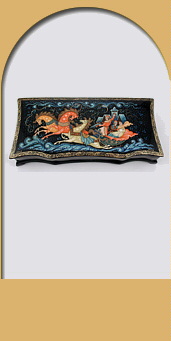How Laquer Box Art
is made
Russian Art History
Sharing
Culture

|
The following is a description of the making of a Palekh box. However, most boxes are constructed in a very similar manner. The box begins with ordinary cardboard, which is cut into narrow strips and pasted with glue made from wheat flower. These strips are then built around a form that gives the box its size and shape. When the right thickness is achieved it is put into a mechanical press before being dried for fifteen days at room temperature. After a bath of linseed oil for twenty-four hours, the cardboard is heated for four days in an iron box, itself within an oven, at 120 degrees Centigrade, becoming then as strong as the hardest wood—and able to withstand atmospheric conditions that ordinary wood couldn’t. Next, lathe operators and joiners grind the box and put on the bottom and the metal hinges. At this stage the box is sanded smooth and three layers of primer containing ash and river clay is applied, being oven dried and smoothed down between coats. Then, the inner and outer surfaces are painted with mixtures of oil and ash lacquer. For the red interior, cinnabar and carmine blended with this lacquer are used. Three or four coatings of different lacquers are next applied, with twelve hours drying time between each. Finally, three layers of clear lacquer are applied to the exterior and one to the interior. The box next goes to the artist, who makes a pencil sketch of the subject onto the box. He next gently rubs pumice powder on the box to matte it so that it will hold the paint. Only after all of this can the time consuming and many-layered process of painting the subject matter onto the box begin! |
Return to Little Russia